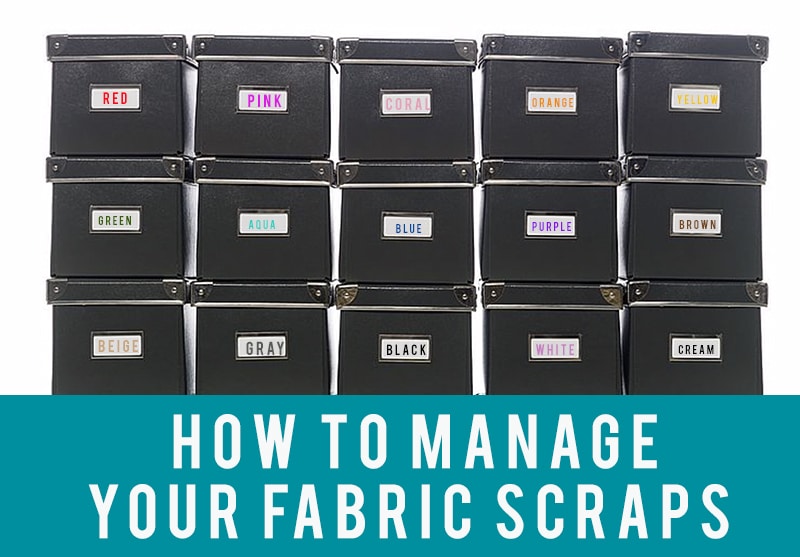
Are you drowning in fabric scraps? Finding “the right way” to tame textiles is something that many of us struggle with. First the bad news: There is no one “right way” to manage fabric scraps. It all depends on what works best for you. Your best method depends on a number of factors, including how you like to organize and pull your fabrics for future projects, how much storage space you have, etc.
Now the good news: This post is full of ideas that you can cobble together to create a system that works for you. I suggest that you read through, see what resonates with you and how you like to work, and then select your best practices.
Fabric Scraps Defined
Quilting has changed drastically over the years, and I’m not talking about the “traditional versus modern” debate. Quilting is rooted in upcycling, making do, and reusing valuable fabric. Because quilters of the past often used pieces of old clothing to create scrappy quilts, they probably kept just about everything.
Today, quilting is recognized as both art and functional craft, and our fabrics are often brand new and selected for a particular project. Some quilters upcycle clothing or use found materials to make their quilts, but it’s not the norm, and that’s okay. Practices evolve, and so do we.
While researching this article, I found that what quilters consider to be “scraps” varies widely – the size of scraps worth saving runs the gamut. Some will save the tiniest pieces, while 5” squares are the cutoff for others. By the end of the article, you may rethink what you’re willing to save as a scrap.
One of the best pieces of advice I saw regarding scraps was this: Don’t waste time worrying about your scraps. Put another way, if you’re spending more time agonizing over or organizing your scraps than you are quilting, that’s a problem. It’s okay to take time to establish a practice and get organized, but not to the point that it paralyzes you, sucks up all your time, or otherwise hinders actual making.

These wee blocks were made by Kitty Wilkin @nightquilter using small scrap pieces
What Can You Do with Your Fabric Scraps?
Here’s an overview – a bird’s eye view of what many of us do with our scraps. Do you do one of these – or more?
- Use scraps regularly in projects
- Give scraps away
- Sell scraps
- Throw scraps away
- Collect scraps without using them until family members finally stage an intervention
I will elaborate a bit on numbers one through four. Let’s try and avoid number five!
Using & Otherwise Making Scraps Disappear
Here are some great ways to use your scraps.
- Make scrappy quilts
- Use smaller scraps for wonky stars, economy blocks, and fussy cutting
- Save small scrap pieces for English Paper Piecing hexies and EPP shapes
Just want to get rid of your scraps?
- Give scraps to friends, who can use them to quilt, sew, stuff pet beds, etc.
- Sell your scraps on Instagram using the hashtag #thegreatfabricdestash
- Mail your scraps to one of The Navajo Quilt Project addresses
- Donate unwanted scraps to an art teacher or elementary school

Fabric storage bins by Kitty Wilkin @nightquilter
How to Manage Your Scraps
SORT: Most quilters seem to organize their scraps in one of these ways:
- Color (one color per drawer, bin, shelf or section)
- Size (Bigger scraps together, smaller scraps together)
- Designer (All Alison Glass together, all Bonnie & Camille together)
I sort all my fabrics by color – including scraps.
CUT: Another tactic quilters use is cutting their scrap fabric into a particular size, so the scraps are immediately ready to use. As soon as a quilt is finished, the leftover scrap fabric gets cut, sorted, and stored.
Here are some examples:
- Fabric is cut into 1 ½”, 2 ½”, 3 ½” or larger strips
- Fabric is cut into 2 ½” squares for postage stamp quilts or hexies
- Fabric is cut into 5” squares. Any pieces smaller than 5” are discarded
Some prefer to cut the scraps into the largest piece possible using the fewest cut possible, since they may need a larger piece later on. What you choose to do should depend on your working style. Are you more likely to use precut squares and strips that are at the ready, or will you do best with larger pieces that can be cut to size?
STORE: There are many ways to store your scraps – from throwing them all into a designated laundry basket in the corner to meticulously organizing them in labeled bins. Some storage options to consider:
- Dresser drawers
- Plastic shoeboxes
- Large Ziplock bags
- Storage bins that fit under the bed
- Rolling drawer bins or cart with wheels
- Open-top bins that fit on square IKEA shelves
- Fabric containers, like the darling ones shown above – made by Kitty Wilkin of Night Quilter. You’ll find her handy tutorial here!
There’s No Wrong Way
The best method is the one you’ll consistently use – the one that allows you to enjoy quilting and sewing to the fullest while avoiding avalanches of untended scraps. I hope this has given you some ideas, on what to do with your scraps and on how to store the pieces you do save.
Need help organizing your quilting and daily life? Let The Quilter’s Planner or The Quilter’s Planner Design Book help!



